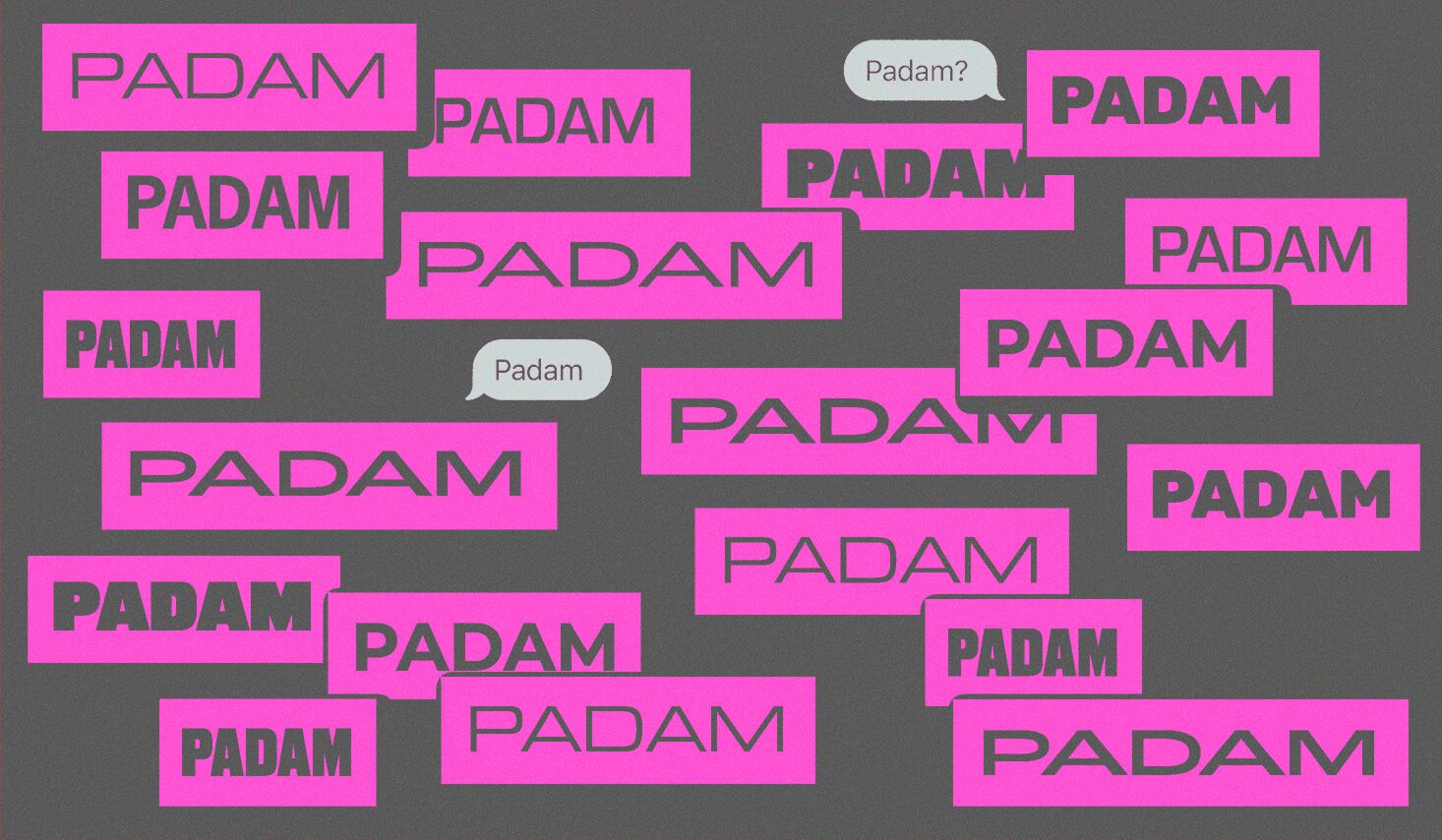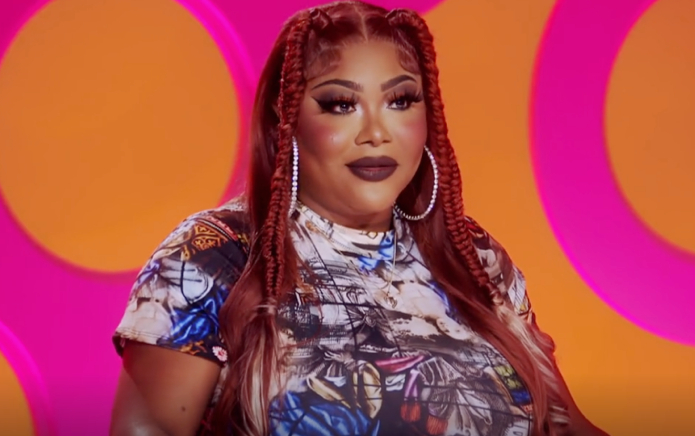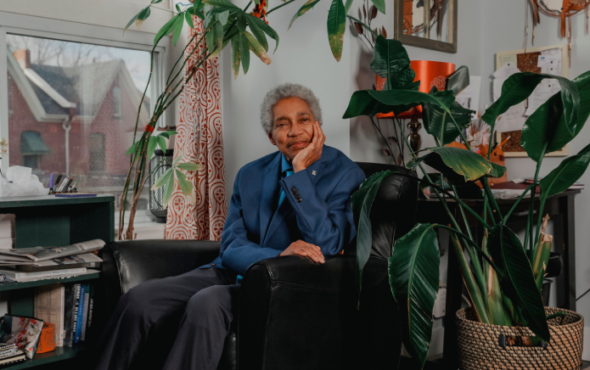
What will you remember when you look back on the summer of 2023? Will it be the pink-drenched colours and plastic smiles of the Barbie movie? The one-in-a-lifetime show-womanship of Beyoncé’s Renaissance tour? Or the moment you lost faith in cishet marriage once the news of RHOBH’s Kyle Richards and Mauricio Umansky separation hit the tabloids? Regardless of whatever pop culture debris sticks with you – like Pride glitter stubbornly pressed against sweaty skin – we already know the song that will be playing in the background as memories flash in front of your eyes like an iPhone photo montage. Yep, it’s ‘Padam Padam’.
Those two words, consisting of two syllables with little discernible meaning, have well and truly taken over LGBTQIA+ life over the past few months. If you need a recap (who can remember life before?) the infectious single, containing a truly hypnotic chorus, comes courtesy of grande dame of queer pop Kylie Minogue and first dropped back in May. Then, it soon began to reverberate throughout the queer underground – soundtracking Pride club nights, joyful days at Mighty Hoopla, lipsyncs by Drag Race legends and camp TikToks chez Hobbycraft Wimbledon – before reaching the UK Top 10 in late June. And, as its presence during Pride in London attested, it shows no sign of leaving the queer ether any time soon.
Admittedly, it comes as little surprise that a Kylie track would become the queer anthem of the summer – shout out to Charli XCX’s ‘Speed Drive’ for coming a close second – but what might have you somewhat more puzzled is the velocity with which the LGBTQIA+ community adopted the word “padam” as their latest queer catchphrase. Exclamations like “slay” or “purr” – while arguably waning for some time now – have officially been left to rot in the graveyard of forgotten gay slang. Instead, “padam” is the only answer – no matter what the question may be – in queer life. Hell, we’ve even got it into Parliament – with MP Lloyd Russell-Moyle namechecking “padam padam” in the House of Commons to mark Pride.
What does “padam” mean?
But what does it actually mean? When I ask the community at large what they think “padam” signifies, the answer is varied. To some, such as designer Grete, it’s as simple as “being a slut (complementary)”. Others, such as queer music professional François, argue that the word transcends meaning; “Honestly, I don’t think it’s intellectualisable, it’s a vibrant je ne sais quoi. Maybe a frequency that makes our cells happy.” Urban Dictionary, which may not always be so reliable but is, at the very least, frequently updated, suggests that padam is about embodying a certain level of iconicness and impressing that upon others; “An onomatopoeia for the sound a heartbeat makes when you’re a diva who’s slaying, coined by Kylie Minogue.”
Clearly, there’s a lot of conflicting definitions out there. One of the most commonly cited meanings can be found in the video by creator Chris (which has been liked over 280,000 times, FYI) where two queer interviewees reply, without the slightest hesitation, “padam” when asked what their favourite gay slang of the moment is. They then elaborate that the word simply means “being gay and having a great time” which, yeah, kind of tracks – after all, don’t we all just want to enjoy ourselves after all the doom and gloom of the past few years?
What memeing language means for us
But what’s so interesting about the padam-ification of summer 2023 and the ways that the phrase has been adopted into queer slang is that, as it’s used in the song, the word is explicitly anti-verbal. It refers to the sound of a heartbeat – our physical being – and doesn’t necessarily have a clear-cut, intelligible meaning beyond that: like the sonic equivalent of “no thoughts, just vibes”. According to Dr Lucy Jones, an Associate Professor in Sociolinguistics at the University of Nottingham, the word’s lack of pre-established meanings in English is one of the reasons behind its rapid spread. “People have been using padam in lots of different ways, since it doesn’t have a word class. Grammatically speaking, word classes are things like verbs, nouns and adjectives,” she says. “Because padam doesn’t have that, it’s almost operating like a meme – people can use it creatively in whatever way they want since it’s not bound by the normal rules of grammar.”
This is something which Dr Paul Baker, a Professor of English Language at Lancaster University, also picks up on. “Slang is about fun and creativity, so we’re seeing Padam being used in all sorts of ways. People are using it as a kind of general exclamation, sometimes adding emojis after it,” Baker argues. “I’ve also seen it being used as a kind of call and response on social media – with people writing Padam? and responding with Padam! People are verbing it (padaming), and punning it to bits (we live in a padamic, Padam and Steve etc). I particularly like Padamn!”
Padam, passwords and Polari
But whatever form “padam” takes and however it’s used, both experts mention that the word’s signposting of queer identity connects 2023’s padamania to a much longer queer history. In the past, queer people have historically communicated in secret languages in order to recognise one another in public and to signpost their LGBTQIA+ identity without detection. In the UK, this language took the form of Polari: a subcultural dialect which incorporated words from various romance languages, Romani and Yiddish, and was mostly used among gay men. To this day, Polari words like “camp”, “naff” and “bevvy” are all still used and in the Philippines the queer dialect Swardspeak is still used.
But in the UK, legal and social changes which have led to greater acceptance of the LGBTQIA+ community mean that queer people don’t have to use their own distinct, secret dialect anymore. Yet that doesn’t mean that queer people don’t cultivate their own vocabulary away from cis-het norms. “There isn’t as much need for a completely secret code [like Polari] that you have to learn. However, there is absolutely language that is used in order to signal your membership to a kind of broader queer community,” explains Dr Jones. This is what she terms a “queer lexicon,” by which she means an LGBTQIA+ vocabulary or set of frequently used words, rather than a more fleshed-out, in-depth queer dialect or language such as Polari.
LGBTQIA+ pop culture and the queer lexicon
Rather than words which you pick up in education or via a dictionary, our queer lexicon is developed through more informal means – mostly spending time in the community or consuming queer media. “It’s very common for people who spend time within the queer scene, with other queer people or engaging with queer media to pick up on language that is used. You might see people use, for example, a lot of words and phrases from things like RuPaul’s Drag Race whereas, in the past, terms from The L Word or Queer as Folk might have been used,” she explains.
As Kylie fan and pop culture journalist Alim Kheraj explains, queer media is key for developing the language we use in our social circles – though often queer media is lifting from real LGTBQIA+ life. “There is a sense of a uniquely queer language, which is often taken from media. I think [media and language] inform each other although I’m sure that queer media, because it’s made by queer people, takes things from queer people,” he explains. “I do think it’s hard to tell what might make its way into queer lexicon. I think Padam’s addition felt natural just because of who the song is by and how fun it is.”
For Baker, the success of “padam” – both the word and the song it references – is partly due to the way it harks back to an earlier song by Edith Piaf, herself a queer icon, and is inextricable from the ways Kylie has been queer-coded and claimed by LGBTQIA+ folk. “Kylie has had a huge gay following for what feels like several centuries, she still looks the same as she did in the 1990s, and she is almost universally loved, so anything she says, wears or does will instantly be embraced by her fans,” he explains. This is something which Joseph, who runs the Kylie Minogue fan account Minogue Updates, echoes. “Kylie is an LGBTQIA+ icon,” he says over DM. “Her music connects to the community.”
Dr Jodie Taylor, a musicologist and the author of Playing It Queer, explains that the history of queer stans revering pop divas like Kylie has a more illustrious lineage than we might realise. “The diva is a huge part of music culture – she’s a gay icon though she might not serve the same role for lesbians or bisexual people as she might do for gay men,” she explains. “The diva is a symbol which gay men can project themselves onto. Historically, in gay culture of the 19th and 18th centuries, men worshipped opera divas, just as people worship pop divas today. It becomes a symbolic kind of projection of an imagined esteem that gay men didn’t have.”
While the opera divas of old might not have been able to publicly acknowledge and celebrate their queer fanbases, the relationship between diva and fan is now much more reciprocal – the padam flames have no doubt been fanned by Kylie chiming in on the vast quantity of internet talk and memes, telling fans to “keep them coming”. “The relationship between gay fan bases and divas is now totally mutual and something that serves both the performer and the audience,” Taylor explains. While the benefits for pop divas cultivating and recognising a queer fanbase are obvious – concert ticket sales, streams, coordinated social media adoration, I could go on – for queer fans, it can be repaid with acts of allyship or advocacy from pop divas on behalf of the community or prioritising queer-centred performances at events like Pride.
Queer pop as an expression of LGBTQIA+ identity
But it’s important to note that Kylie’s music doesn’t just resonate with the community – it helps members of the community connect with one another. As Baker explains, “padam” is currently something of an informal symbol of LGBTQIA+ identity. “Padam is a word which acts as a signifier for the gay community – if you see it on social media, you’ll recognise someone as likely to be queer or at least queer-friendly.”
But it can run deeper than that, too. As Dr Jones argues, queer vocabulary can form a much broader part of our identity, and can sit alongside how we present ourselves physically as a form of self-expression. “When people then use that language themselves, it’s kind of saying, ‘Hey, look, I’m part of this community and I identify in the same way as you do’,” she says. “Using particular words, much like having a particular kind of tattoo or a particular kind of hairstyle, allows people to express their identity as a queer person.”
And perhaps it’s that recognition and the power of being seen and accepted as a member of the queer community which has led to the song – and the word’s – runaway success among LGBTQIA+ folk. As Ms Minogue has explained herself, when we utter “padam” in queer company, we can be comfortable in knowing that we are understood and in dialogue with our peers throughout the community; “There is a call and response. Say it, then you have to say it back. Answer, or answer yourself.”



